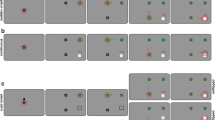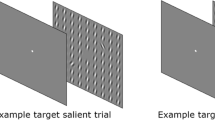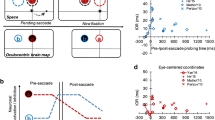Abstract
Previous research has shown that in order to make an accurate saccade to a target object, nearby distractor objects need to be inhibited. The extent to which saccade trajectories deviate away from a distractor is often considered to be an index of the strength of inhibition. The present study shows that the mere expectation that a distractor will appear at a specific location is enough to generate saccade deviations away from this location. This suggests that higher-order cognitive processes such as top-down expectancy interact with low-level structures involved in eye movement control. The results will be discussed in the light of current theories of target selection and possible neurophysiological correlates.




Similar content being viewed by others
Notes
To test whether there was a difference in the magnitude of the expectation effect on the saccade trajectory deviations between the two experiments, we run a mixed ANOVA with Experiment as a between-subjects factor. There was no interaction between Experiment and condition (F<1) suggesting that the magnitude of the expectation effect was similar in both experiments. There was no main effect of Experiment (F<1).
References
Basso MA, Wurtz RH (1997) Modulation of neuronal activity by target uncertainty. Nature 389:66–69
Basso MA, Wurtz RH (2002) Neuronal activity in Substantia Nigra Pars Reticulata during target selection. J Neurosci 22(5):1883–1894
Becker W, Juergens R (1979) An analysis of the saccadic system by means of double step stimuli. Vision Res 19:967–983
Bergeron A, Matsuo S, Guitton D (2003) Superior colliculus encodes distance to target, not saccade amplitude, in multi-step gaze shifts. Nat Neurosci 6(4):404–413
Bichot NP, Schall JD (2002) Priming in macaque frontal cortex during popout visual search: Feature-based facilitation and location-based inhibition of return. J Neurosci 22:4675–4685
Doyle MC, Walker R (2001) Curved saccade trajectories: Voluntary and reflexive saccades curve away from irrelevant distractors. Exp Brain Res 139:333–344
Erkelens CJ, Sloot OB (1995) Initial directions and landing positions of binocular saccades. Vision Res 35:3297–3303
Findlay JM, Harris LR (1984) Small saccades to double-stepped targets moving in two dimensions. In: Gale AG, Johnson FW (eds) Theoretical and applied aspects of eye movement research. Elsevier, North-Holland, pp 71–78
Frens MA, Van Opstal AJ, Van der Willigen RE (1995) Spatial and temporal factors determine auditory-visual interactions in human saccadic eye movements. Percept Psychophys 57:802–816
Gancarz G, Grossberg S (1999) A neural model of the saccadic eye movement control explains task-specific adaptation. Vision Res 39:3123–3143
Georgopoulos AP (1995) Current issues in directional motor control. Trends Neurosci 18:506–510
Godijn R, Theeuwes J (2002a) Oculomotor capture and inhibition of return: evidence for an oculomotor suppression account of IOR. Psychol Res 66:234–246
Godijn R, Theeuwes J (2002b) Programming of endogenous and exogenous saccades: evidence for a competitive integration model. J Exp Psychol Hum Percept Perform 28(5):1039–1054
Godijn R, Theeuwes J (2004) The relationship between inhibition of return and saccade trajectory deviations. J Exp Psychol Hum Percept Perform 30(3):538–554
Goossens HH, Van Opstal AJ (2000) Blink-perturbed saccades in monkey. II. Superior colliculus activity. J Neurophysiol 83:3430–3452
Houghton G, Tipper SP (1994) A model of inhibitory mechanisms in selective attention. In: Dagenbach D, Carr TH (eds) Inhibitory processes in attention, memory, and language. Academic, New York
Komatsu H, Suzuki H (1985) Projections from the functional subdivisions of the frontal eye field to the superior colliculus in the monkey. Brain Res 327:324–327
Kopecz K (1995) Saccadic reaction times in gap/overlap paradigms: A model based on integration of intentional and visual information on neural dynamic fields. Vision Res 35:2911–2925
Levy-Schoen A (1969) Determination et latence de la reponse oculo-motrice a deux stimulus simultanes ou successifs selon leur excentricite relative. Annee psychol 69:373–392
Ludwig CJH, Gilchrist ID (2002) Measuring saccade curvature: a curve fitting approach. Behav Res Methods Instrum Comput 34:618–624
Ludwig CJH, Gilchrist ID (2003) Target similarity affects saccade curvature away from irrelevant onsets. Exp Brain Res 152:60–69
McPeek RM, Han JH, Keller EL (2003) Competition Between Saccade Goals in the Superior Colliculus Produces Saccade Curvature. J Neurophysiol 89(5):2577–2590
McPeek RM, Keller EL (2004) Deficits in saccade target selection after inactivation of superior colliculus. Nat Neurosci 7:757–763
McSorley E, Haggard P, Walker R (2004) Distractor modulation of saccade trajectories: spatial separation and symmetry effects. Exp Brain Res 155:320–333
Minken AWH, Van Opstal AJ, Van Gisbergen JAM (1993) Three-dimensional analysis of strongly curved saccades elicited by double-step stimuli. Exp Brain Res 93:521–533
Moschovakis AK (1996) The superior colliculus and eye movement control. Curr Opin Neurobiol 6:811–816
Munoz DP (2002) Commentary: saccadic eye movements: overview of neural circuitry. Prog Brain Res 140:89–96
Munoz DP, Istvan PJ (1998) Lateral inhibitory interactions in the intermediate layers of the monkey superior colliculus. J Neurophysiol 79(3):1193–1209
Munoz DP, Schall JD (2003) Concurrent, distributed control of saccade initiation in the frontal eye field and superior colliculus. In: Hall WC, Moschovakis AK (eds) The superior colliculus: new approaches for studying sensorimotor integration. CRC Press, Boca Raton
Quaia C, Optican LM, Goldberg JH (1998) The maintenance of spatial accuracy by the perisaccadic remapping of visual receptive fields. Neural Netw 11:1229–1240
Rizzolatti G, Riggio L, Dascola I, Umilta C (1987) Reorienting attention across the horizontal and vertical meridians: Evidence in favor of a premotor theory of attention. Neuropsychologia 25:31–40
Rizzolatti G, Riggio L, Sheliga BM (1994) Space and selective attention. In: Umilta C, Moscovitch M (eds) Attention and Performance XIV. MIT Press, Cambridge
Schall JD (1991) Neuronal basis of saccadic eye movements. In: Leventhal AG (ed) Vision and visual dysfunction. The neural basis of visual function, vol 4. Macmillan Press, London, pp 388–442
Schlag-Rey M, Schlag J, Dassonville P (1992) How the frontal eye field can impose a saccade goal on superior colliculus neurons. J Neurophysiol 67:1003–1005
Sheliga BM, Riggio L, Rizzolatti G (1994) Orienting of attention and eye movements. Experimental Brain Res 98:507–522
Sheliga BM, Riggio L, Rizzolatti G (1995) Spatial attention and eye movements. Experimental Brain Res 105:261–275
Sparks DL, Hartwich-Young R (1989) The deeper layers of the superior colliculus. In: Wurtz RH, Goldberg ME (eds) Rev. Oculomotor Res., The neurobiology of saccadic eye movements. Elsevier, Amsterdam, pp 213–255
Theeuwes J, Chizk C, Olivers CNL (2005) Remembering a location makes the eyes curve away. Psychol Sci 16:196–199
Theeuwes J, Godijn R (2004) Inhibition-of-return and oculomotor interference. Vision Res 44:1485–1492
Theeuwes J, Kramer AF, Hahn S, Irwin DE (1998) Our eyes do not always go where we want them to go: capture of eyes by new objects. Psychol Sci 9:379–385
Tipper SP (1985) Selective attention and priming: inhibitory and facilitatory effects of ignored primes. Q J Exp Psychol 37A:591–611
Tipper SP, Howard DV, Houghton G (2000) Behavioral consequences of selection from population codes. In: Monsell S, Driver J (eds) Attention and performance, vol 18. MIT Press, Cambridge, pp 223–245
Tipper SP, Howard LA, Jackson SR (1997) Selective reaching to grasp: Evidence for distractor interference effects. Visual Cognit 4:1–38
Trappenberg TP, Dorris MC, Munoz DP, Klein RM (2001) A model of saccade initiation based on the competitive integration of exogenous and endogenous signals in the superior colliculus. J Cognit Neurosci 13:256–271
Van der Stigchel S, Theeuwes J (2005) The influence of attending to multiple locations on eye movements. Vision Res 45(15):1921–1927
Van Gisbergen JAM, Van Opstal AJ, Roebroek JGH (1987) Stimulus-induced midflight modification of saccade trajectories. In: O’Regan JK, Levy-Schoen A (eds) Eye movements From physiology to cognition. Elsevier, Amsterdam, pp 27–36
Viviani P, Berthoz A, Tracey D (1977) The curvature of oblique saccades. Vision Res 17:661–664
Wurtz RH, Goldberg ME, Robinson DL (1980) Behavioral modulation of visual responses in the monkey: Stimulus selection for attention and movement. Progress Psychobiol Physiol Psychol 9:43–83
Acknowledgements
This research was funded by a grant from NWO (Netherlands organization for Scientific Research), grant 402-01-630-PROG to Jan Theeuwes.
Author information
Authors and Affiliations
Corresponding author
Rights and permissions
About this article
Cite this article
Van der Stigchel, S., Theeuwes, J. Our eyes deviate away from a location where a distractor is expected to appear. Exp Brain Res 169, 338–349 (2006). https://doi.org/10.1007/s00221-005-0147-2
Received:
Accepted:
Published:
Issue Date:
DOI: https://doi.org/10.1007/s00221-005-0147-2




